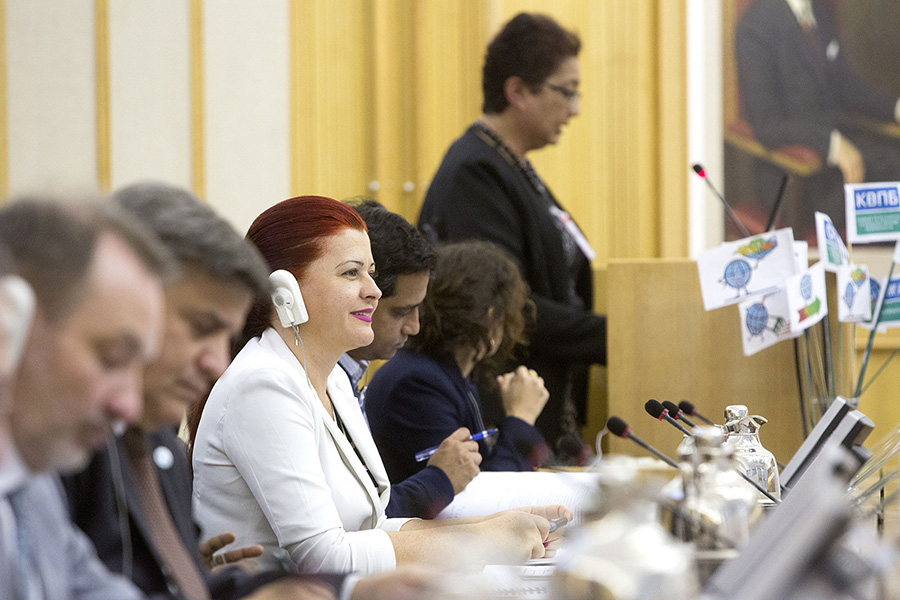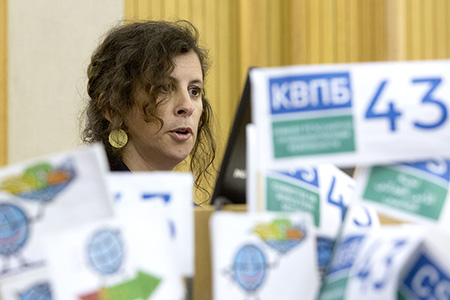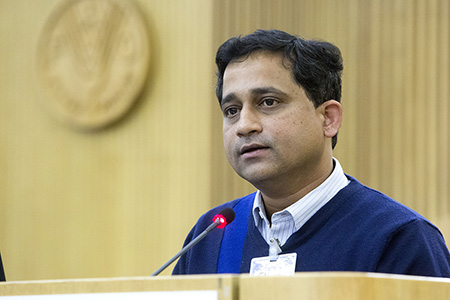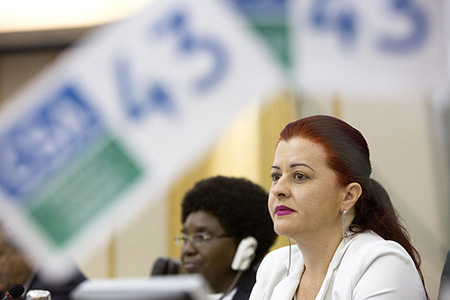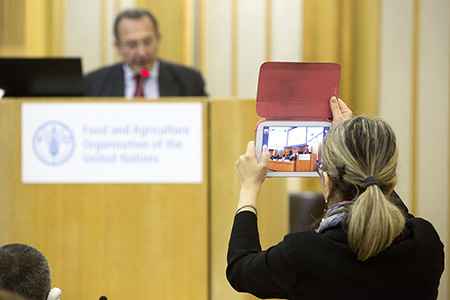Summary
The following side events were covered by ENBOTS on Wednesday, 19 October 2016 please:
- The UN Decade of Action on Nutrition 2016-2025 – CFS Expectations and Opportunities for Engagement
- Grasscutters, Clinics and Spider Plants
IISD Reporting Services, through its ENB+ Meeting Coverage, has provided web coverage of CFS 43 and selected side-events. The summary report of CFS 43 is available in HTML and PDF.
The UN Decade of Action on Nutrition 2016-2025 – CFS Expectations and Opportunities for Engagement
Organized by FAO, WHO, Brazil, Italy, Russian Federation, South Africa, CMS, HLPE and academia
This side event, chaired by Kostas Stamoulis, FAO Assistant Director-General, highlighted efforts being made by governments and organizations to promote the UN Decade of Action on Nutrition (2016-2025) and progress towards achieving SDG targets on nutrition. Stamoulis stressed that the UN Decade is an opportunity for relevant stakeholders across all sectors to work together to eradicate hunger and prevent malnutrition, and to achieve nutrition impact at scale.
Amira Gornass, CFS Chair, stressed the need to scale up international commitments to stop malnutrition in all its forms and to advance a global nutrition agenda. She said that the UN Decade acts as an umbrella for stakeholders to align actions to meet global nutrition targets outlined in the Second International Conference on Nutrition (ICN2) and the 2030 Agenda for Sustainable Development. She added that the CFS can play a key role in supporting engagement under the Decade.
Francesco Branca, WHO, said the UN Decade calls on Member States to act across six pillars: sustainable food systems for healthy diets; aligned health systems providing universal coverage of essential nutrition actions; social protection and nutrition education; trade and investment for improved nutrition; enabling food and breastfeeding environments; and review, strengthen and promote nutrition governance and accountability.
Jessica Fanzo, John Hopkins University, USA, called for governments to commit to achieving national nutrition targets and to put in place monitoring systems that allow them and others to assess progress. She said commitments should be measurable, achievable and realistic, and relevant to a country’s situation and national priorities.
Michele Lessa de Oliveira, Ministry of Health, Brazil, noted successful public policies that emphasize an increase in fruit and vegetable intake and a reduction of sweet drinks. She cited an agreement between the Brazilian Ministry of Health and the Brazilian Food Industry Association that has contributed to avoiding the use of 14,900 tons of sodium in food since 2011.
Giuseppe Ruocco, Ministry of Health, Italy, noted Italy’s commitment to global food security by expanding its support to the World Food Programme, and the ministry’s work with the local food industry to review dietary composition in products in an effort to improve health.
Ivan Konstantinopolskiy, Permanent Mission of Russia to FAO, noted that his government is implementing policies to improve diets, especially as half of the population is facing overweight and obesity problems; and others are experiencing nutrient deficiencies such as low levels of vitamins and minerals. He said, his government has contributed US$6 million to an FAO project to strengthen food security and nutrition in Central Asia.
Joyene Sirene Isaacs, West Cape Department of Agriculture, South Africa, said that food security policy in South Africa includes nutrition security, suggesting that sustainable agriculture should form the basis to combat hunger and malnutrition. She added that mitigation and adaptation resilience to climate change is critical for sustainable agriculture production.
Biraj Patnaik, Right to Food Campaign, India, proposed four pillars when framing nutrition issues: centrality of human rights to food, health, water and natural resources; management of malnutrition throughout the lifecycle; centrality of sovereign, local food systems; and democratic governance and regulatory frameworks. He stressed that meeting ambitious nutrition targets should be framed around the universal recognition of human rights.
In the ensuing discussion, participants addressed, inter alia, how CFS can contribute to the Decade of Action on Nutrition, accountability for attaining nutrition-focused goals; the effectiveness of commitments and their impact; the need for joint collaboration between health and food sectors to achieve action; and securing more resources to fund nutrition activities.
Jessica Fanzo, John Hopkins University, USA
©FAO/Pier Paolo Cito
Biraj Patnaik, Right to Food Campaign, India
©FAO/Pier Paolo Cito
Michele Lessa de Oliveira, Ministry of Health, Brazil
©FAO/Pier Paolo Cito
©FAO/Pier Paolo Cito
Contacts:
-
Marzella Wustefeld, WHO – wustefeldm@who.int
Trudy Wijnhoven, FAO – ESN-Director@fao.org
More Information:
Grasscutters, Clinics and Spider Plants
Organized by Bioversity International, FAO, Canada, Scaling Up Nutrition Movement, World Vision International
This side event, moderated by Boitshepo Bibi Giyose, FAO, explored the multi-sectoral nature of scaling up production and use of good nutrition and sustainable diets, and what it means to work through a collaborative mechanism to deliver food security.
Stefan Germann, World Vision, said that to succeed in scaling up sustainable food production, a multi-sectorial approach is needed that embraces complexity. This, he noted, includes bringing a range of actors from different sectors to help turn policy into practical reality at the local level, as well as new, innovative approaches, such as e-learning, to scale up capacities. He added that this is the goal of SDG 17 – to strengthen the means of implementation and revitalize the global partnership for sustainable development.
Miriam Yiannakis, World Vision, described a successful distance learning programme that helped a regional nutrition officer in Ghana identify local foods that can be used to treat anemia and stunting. This food-based approach, she said, not only addresses malnutrition but also reintroduces traditional foods back into the daily diet. Such e-learning courses, she added, facilitate capacity building and identifying local resources and partnerships, which in turn transforms action on nutrition.
Victor Wasike, Bioversity International, reported on a multi-sectoral approach to achieve good nutrition in Kenya by mainstreaming indigenous African vegetables, like spider plants, to be served in schools. He said the success of the approach was possible by bringing together government ministries, county officials and local groups, including schools, youth groups, women groups, farmers and community health groups.
George Kembo, Scaling Up Nutrition (SUN) Movement, noted that despite all the structures and systems in place to address health and nutrition, countries need a strong multi-sectoral approach to face the challenges. He stressed, however, that not one sector can do it alone and that it takes different sectors with communities to plan and deliver strategies to combat hunger and malnutrition. He suggested tapping into the knowledge of elders when it comes to nutrition.
Jean-Marc Faures, FAO, outlined five principles for sustainable food and agriculture: improving efficiency in the use of resources is crucial to sustainable agriculture; sustainability requires direct action to conserve, protect and enhance natural resources; agriculture that fails to protect and improve rural livelihoods, equity and social well-being is unsustainable; enhanced resilience of people, communities and ecosystems is key to sustainable agriculture; and sustainable food and agriculture requires responsible and effective governance mechanisms. He said these principles, through a multi-sectoral approach, will help achieve the SDGs and the 2030 Agenda for Sustainable Development.
Maarten De Groot, Global Affairs, Canada, said getting more nutritious foods to children and families requires coordinated effort and multiple tools, including direct interventions, such as school feeding programmes, and outcome-based financing (e.g., AgResults developing aflatoxin-resistant maize). He added that multiple stakeholders can each contribute to strategies and plans each according to their strengths; for example, the public sector through research and extension), the private sector through marketing and product development and civil society by engaging communities.
In discussions, participants considered, inter alia, low-implementing capacity; nutrition education and how to motivate e-learners; looking to schoolchildren as an agriculture community; and balancing the interests of different groups, including the private sector.
Contacts:
- Loria Kulathungam, World Vision, loria_kulathungam@worldvision.ca
- Florence Lasbennes, SUN, florence.lasbennes@undp.org
- Boitshepo Giyose, FAO, boitshepo.giyose@fao.org
More Information:
- https://www.worldvision.ca
http://scalingupnutrition.org
http://www.fao.org/home/en
https://www.bioversityinternational.org
